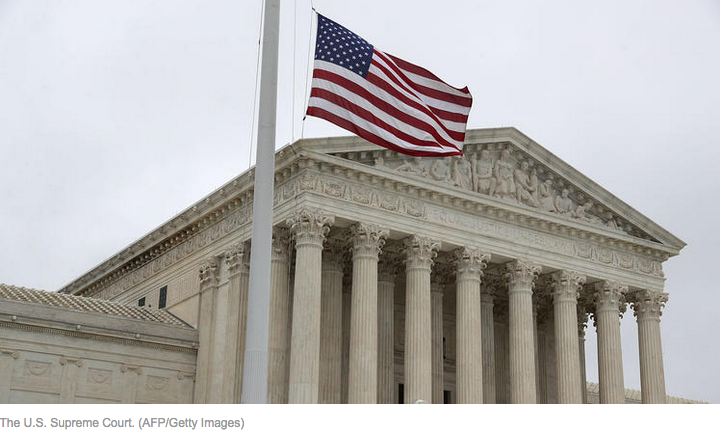Trump’s victory ensures a conservative majority on the Supreme Court
Donald Trump’s presidential victory preserves the Supreme Court’s narrow conservative majority by clearing the way for the new president to choose a jurist next year to fill the seat of the late Justice Antonin Scalia.
And with Republicans maintaining control of the Senate, Trump will have a free hand in selecting someone with strong conservative credentials, confident his nominee will be confirmed.
The election dashes the hopes of liberals, who lost their best opportunity in more than 40 years to create a majority on the high court.
It also provided a validation of sorts for the obstruction strategy of Senate Majority Leader Mitch McConnell (R-Ky.) and other Republicans, who refused for nearly nine months to consider President Obama’s nominee to fill Scalia’s seat, Merrick Garland, chief judge of the U.S. Court of Appeals for the District of Columbia Circuit.
The future of the Supreme Court’s ideological balance proved to be a critical factor for many Republican voters. In exit polls, about 1 in 5 voters said the Supreme Court appointments were “the most important factor” in their decision, and those voters favored Trump by a 57% to 40% margin, according to ABC News.
Now, the court’s ideological balance should remain largely as it has been for the past decade, with Justice Anthony M. Kennedy holding the deciding vote in the court’s biggest cases.
Kennedy generally leans to the right on issues such as campaign spending, criminal law, the death penalty, religion, business regulation and gun rights. But he has joined the court’s four liberals to uphold gay rights and to protect blacks from housing discrimination.
Trump’s nominee to replace Scalia is not likely to trigger an immediate shift on abortion. In June, Kennedy joined with the liberals to strike down a Texas law that would have forced the closing of most of the state’s abortion clinics, signaling the Roe vs. Wade decision and the right to abortion retains a majority, at least for now.
But going forward, GOP control of the White House and the Senate means the court could shift strongly to the right in the next four years if Justices Ruth Bader Ginsburg, 83, Kennedy, 80, or Stephen Breyer, 78, were to leave the court.
“Filling the Scalia seat is probably a wash. But the odds are very high that in four or eight years, President Trump will have other vacancies to fill, and that will be a different story,” said John Malcolm, a legal analyst at the Heritage Foundation, a conservative think tank.
Ginsburg may find herself in an uncomfortable spotlight. Some leading liberals had urged her to retire two years ago so Obama could have filled her seat with a younger liberal justice. Ginsburg said she saw no reason to retire and suggested she was confident another Democrat would follow Obama in the White House.
If President Trump were to replace Ginsburg or Breyer, it would give the court a dominant conservative bloc with six Republican appointees and no need to rely on Kennedy for some issues, notably abortion and gay rights. Trump said in one debate that he would appoint pro-life justices, and they would overturn Roe vs. Wade.
Trump’s nominees also are likely to be strong supporters of the 2nd Amendment and its right to bear arms. If so, the court could stand as a roadblock against city or state gun regulations, including measures that make it hard for gun owners to obtain concealed carry permits.
And with a new appointee, the court could deal a blow to public-sector labor unions. Last year, the conservative justices were prepared to rule in a case involving California teachers concerning whether it is constitutional to require such employees to pay mandatory fees to support their unions. But Scalia died unexpectedly before the opinion could be issued, leaving the court split, 4-4. Now, conservative activists could bring the issue back to the court.
And Trump’s victory likely guarantees the end of Obama initiatives on immigration and climate change. Conservative judges and an evenly divided high court had put those measures on hold. The court now will soon have a conservative majority to kill those initiatives, assuming they are not repealed first by the Trump administration.
Liberals are worried about what lies ahead. “Longer term, there are real concerns about whether a Supreme Court with two or three Trump-nominated justices would cut back on protections for important fundamental rights and liberties, especially the right of women to meaningfully access abortion,” said Elizabeth Wydra, president of the Constitutional Accountability Center. “We could see a court more willing to look out for corporate interests at the expense of consumers and workers or to break with the guarantees of equality for LGBTQ Americans.”
During the campaign, Trump issued two lists of his potential Supreme Court nominees, including judges from state supreme courts and U.S. appeals courts across the nation. They include Florida Supreme Court Justice Charles Canady, who as a congressman sponsored the federal ban on “partial-birth abortions”; Michigan Supreme Court Justice Joan Larsen, a former Scalia law clerk; 11th Circuit Court Judge William Pryor from Alabama; 7th Circuit Judge Diane Sykes from Wisconsin and Sen. Mike Lee from Utah.
Source: latimes.com
 Listen Online
Listen Online Watch Online
Watch Online Find a Station in Your Area
Find a Station in Your Area








 Listen Now
Listen Now Watch Online
Watch Online
